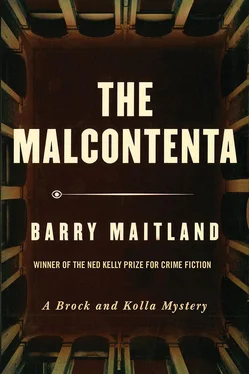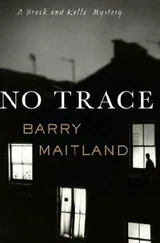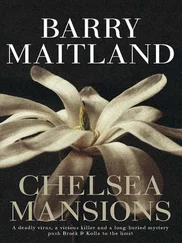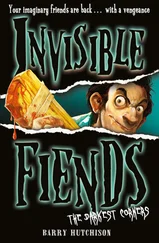Barry Maitland - The Malcontenta
Здесь есть возможность читать онлайн «Barry Maitland - The Malcontenta» весь текст электронной книги совершенно бесплатно (целиком полную версию без сокращений). В некоторых случаях можно слушать аудио, скачать через торрент в формате fb2 и присутствует краткое содержание. Год выпуска: 2013, Издательство: Arcade Publishing, Жанр: Полицейский детектив, на английском языке. Описание произведения, (предисловие) а так же отзывы посетителей доступны на портале библиотеки ЛибКат.
- Название:The Malcontenta
- Автор:
- Издательство:Arcade Publishing
- Жанр:
- Год:2013
- ISBN:нет данных
- Рейтинг книги:5 / 5. Голосов: 1
-
Избранное:Добавить в избранное
- Отзывы:
-
Ваша оценка:
- 100
- 1
- 2
- 3
- 4
- 5
The Malcontenta: краткое содержание, описание и аннотация
Предлагаем к чтению аннотацию, описание, краткое содержание или предисловие (зависит от того, что написал сам автор книги «The Malcontenta»). Если вы не нашли необходимую информацию о книге — напишите в комментариях, мы постараемся отыскать её.
The Malcontenta — читать онлайн бесплатно полную книгу (весь текст) целиком
Ниже представлен текст книги, разбитый по страницам. Система сохранения места последней прочитанной страницы, позволяет с удобством читать онлайн бесплатно книгу «The Malcontenta», без необходимости каждый раз заново искать на чём Вы остановились. Поставьте закладку, и сможете в любой момент перейти на страницу, на которой закончили чтение.
Интервал:
Закладка:
She hadn’t worked with Dowling before and asked the question as much to make conversation as anything, as he’d been very quiet since they got in the car. He chewed his lip for a moment, concentrating on a bend.
‘Er … some kind of health farm, I believe, Sarge.’
‘Call me Kathy. You’re Gordon, aren’t you?’
‘Er … yeah, that’s right, Sarge.’
Sleepy Dowling, Kathy said to herself. Thanks a lot, Inspector Tanner.
There were puddles by the road from the recent rain, and the woods looked sodden. Through Edenham, a small market town whose streets were still almost deserted this Monday morning; lights on in the two glass-fronted supermarkets which had pushed their way in among the old brick and halftimbered houses of the high street; the largest building in the street a pub, formerly a coaching inn, the Hart Revived, whose painted sign of a deer drinking from a pool was suspended over the pavement. Beyond the town, more belts of dark conifers; then high hedges closed in on either side. Sporadic patches of mist crossed the road and Dowling slowed, peering forward through the windscreen.
‘Somewhere around here …’ he muttered. Then, with satisfaction, ‘There!’
A signpost marked STANHOPE indicated a narrow lane branching to the right. More hedges, then a cattle grid, beyond which the hedges stopped abruptly, opening up a rolling landscape of sheep-cropped grass dotted with small copses of oak and beech. They came to a river, maybe ten yards wide, which they followed until a bridge appeared, a single high arch of weathered grey stone decorated with elaborately carved balusters and urns.
‘Wow,’ Kathy said, and then repeated herself a moment later as Dowling carefully steered the car up to the crown of the arch, and a panorama of Stanhope House, half shrouded in a bank of silver mist, presented itself before them. A pale-grey cube made of the same stone as the bridge, in the same classical style and embellished with a tall pedimented portico, the Palladian villa’s original simplicity and symmetry had been ruined by a later wing grafted on to the left side, like the single ungainly claw of a hermit crab thrust out of a perfect shell.
On the far side of the bridge the metalled road curved away to the right, and a gravel road branched off it towards the house. Beside the junction stood a dark-green sign with white lettering, STANHOPE NATUROPATHIC CLINIC, beneath a symbol based on the design of the front portico of the house. The winding gravel road took them around the edge of the meadow which lay in front of the house, and soon revealed a red-brick stable block among the trees further to the left. Perhaps thirty cars — Jaguars, BMWs and Mercedes accounting for more than half — stood in the area between the stables and the house.
‘No sign of the patrol car,’ Dowling said, and then spotted a uniformed officer standing under the trees. He slowly rolled forward and Kathy lowered her window, filling the car with cool morning air sharp with autumnal smells of damp and rotting leaves.
‘You follow that path’ — the man pointed to a gravelled way leading off through the trees between the stables and the house — ‘past the staff cottages to a turning circle at the end. You’ll see the patrol car there. The body’s in another building in the grounds on the other side of the main house.’ He sounded cheerful. ‘Young male. One of the staff, apparently. My partner’s round there waiting for you with the bloke that found him and the Director of this place. I’ll stay here for the doc’
Kathy nodded. ‘Why did you call for CID?’ she asked.
He hesitated a moment, then, ‘Just to be on the safe side, Sarge.’ He grinned and stepped back to let them continue.
Once through the trees, they passed four identical brick cottages set out like doll’s houses along the curve of the drive, each fronted by a narrow bed filled with recently pruned rose bushes. Between the houses they caught glimpses of the high brick backdrop of a walled garden. Soon they saw the patrol car ahead of them, the driver’s door open, a man in uniform sitting behind the wheel, looking up from his notepad. A dozen paces away stood two men, watching them approach, waiting.
Kathy got out and walked briskly to the patrol car as the officer got to his feet. She introduced herself, keeping her voice low. ‘What’s going on?’
‘We answered a 999 call timed at 0832. Arrived here at 0845. The Director of the clinic, over there, Dr Stephen Beamish-hyphen-Neweir — the policeman spoke with a strong cockney accent and pronounced the name laboriously, raising one eyebrow, as if there were something dubious about it — ’met us at the front of the main building and brought us back here to a building they call the Temple of Apollo’ — again the raised eyebrow — ‘behind the trees over there.’ He pointed with his chin towards a dense thicket of rhododendron, yew and laurel, through the upper part of which Kathy could just make out a stone parapet. In contrast to his partner’s cheerfulness, this man’s forehead was scored with worry. He referred back to the notes on his pad.
‘The other bloke, name of Geoffrey Parsons, is the Estates Manager, looks after the grounds. One of his jobs is to open this temple each morning. Apparently, this morning he found a member of their staff, a Mr Alex Petrou, hanging in there. Stone cold, no chance of resuscitation. He ran back to the main house, found the Director. They both came back out here, then back to the house to ring for us.’
He tore the sheet of notes off the pad and handed it to Kathy, then closed the pad and looked at her uneasily.
‘Why did you ask for CID?’ she asked.
‘I think you should have a look down there, Sergeant. Without those two, I might suggest.’
‘OK.’ She looked over at the two men. There didn’t seem much doubt which was which. One was wearing an old tweed jacket over a thick sweater, and brown corduroy trousers tucked into green gumboots. He wore a tweed cap on his head, which was bowed as he slowly shifted his weight from foot to foot. The other man wore a black double-breasted suit, grey polo-neck sweater and black shoes. His thick black hair stood up from his scalp like a long crew-cut, and the neatly trimmed goatee beard on his chin had a silver streak. He stood motionless, staring intently at Kathy, with his hands clasped in front of him, black leather gloves adding to an effect both theatrical and funereal.
She walked over and he held out his gloved hand. His eyes were very dark, unblinking and hypnotic. She thought what an asset they would be in an interrogation.
His handshake was firm, his voice soft and, surprisingly, almost as broadly cockney as the patrol officer’s. She guessed he was in his forties.
‘I’m Stephen Beamish-Newell, Director of Stanhope, and this is our Estates Manager, Geoffrey Parsons.’
‘Detective Sergeant Kolla and Detective Constable Dowling from County CID, doctor. I understand you’ve both seen the victim and that he is known to you both?’
‘Of course. Alex Petrou.’
‘What can you tell me about him?’
‘Age about thirty, I’d have to check his file to be precise. He came to us last spring, around April I’d say. I took him on as a general physiotherapy assistant. We’re deeply shocked. I don’t think either of us was aware of any problems that might have led him to this.’
He glanced at Parsons, who merely shook his head.
‘I’ll need to get some more details from you, sir, but it’ll probably be more convenient in your office, with your records. I’d like to see the body first, and wait for the doctor. When I’m finished I’ll come back to the house and see you there.’
Beamish-Newell hesitated a moment, as if about to suggest something else, then nodded and turned to go. Parsons made to follow him.
Читать дальшеИнтервал:
Закладка:
Похожие книги на «The Malcontenta»
Представляем Вашему вниманию похожие книги на «The Malcontenta» списком для выбора. Мы отобрали схожую по названию и смыслу литературу в надежде предоставить читателям больше вариантов отыскать новые, интересные, ещё непрочитанные произведения.
Обсуждение, отзывы о книге «The Malcontenta» и просто собственные мнения читателей. Оставьте ваши комментарии, напишите, что Вы думаете о произведении, его смысле или главных героях. Укажите что конкретно понравилось, а что нет, и почему Вы так считаете.












